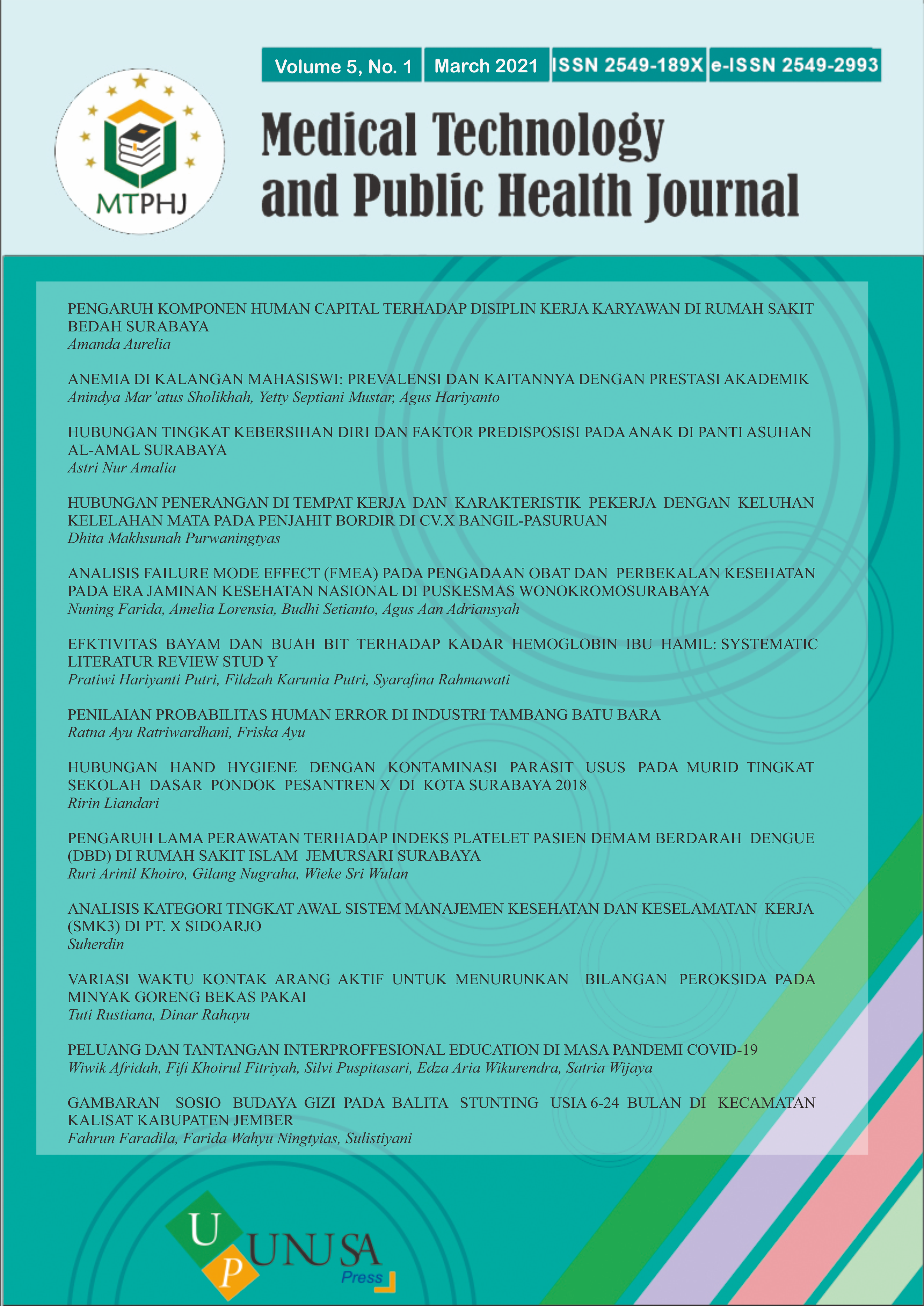Relationship of Hand Hygiene with the Contamination of Parasite Student’s Intestine of Madrasah Ibtidaiyah in X Islamic Boarding School Surabaya
Main Article Content
Abstract
Gastrointestinal infection is the highest cause of morbidity and mortality in developing countries with mortality caused by diarrhea as high as 56%. Parasitic infections spread throughout the world and have been shown to be one of the causes of morbidity and disease in areas that are thought to be beneficial for the growth of intestinal parasitic infections. Giardia lamblia is a parasite that has flagellates that attack mammals, including humans, and is considered the most common cause of diarrhea caused by protozoa around the world. Blastocystis hominis is a parasite that is also common in humans, and infects several animals, such as birds, reptiles and anthropods. The purpose of this study was to see the relationship between hand hygiene and parasitic contamination in students at Islamic Boarding School X in Surabaya. This study was an observational study with a cross sectional research design. This research was conducted at one of the Islamic Boarding Schools in Surabaya. The study sample was Madrasah Ibtidaiyah students who received 10 people who participated 7-13 years. The sampling technique in this study was nonprobabilty sampling. The results of the study obtained Rho Spearman value was p = 0.040. The conclusion is that there is a significant relationship between hand hygiene and intestinal contamination in students' feces at the Islamic Boarding School X in Surabaya. Suggestions that can be given are Islamic Boarding Schools which provide guidance and guidance on clean and healthy life to students, teachers and food managers.
Downloads
Article Details
Copyright (c) 2021 Medical Technology and Public Health Journal

This work is licensed under a Creative Commons Attribution-ShareAlike 4.0 International License.
References
Samie, A., Guerrant, R. L., Barrett, L., Bessong, P. O., Igumbor, E. O., & Obi CL. Prevalence of Intestinal Parasitic and Bacterial Pathogens in Diarrhoeal and Nondiarroeal Human Stools from Vhembe District, South Africa. J Heal Pop Nutr. 2009;27(6):739–745.
City, M., Garcı, R. A., & Lau PM. Intestinal Parasites in Children from a Day Care Centre in Matanzas City, Cuba. 2012;7(12):1–4. Available from: https://doi.org/10.1371/journal.pone.0051394
Luján, H. D., & Svärd S. Giardia: A Model Organism. Wien: Spinger Wien New York; 2011.
Beyhan, Y. E., Yilmaz, H., Cengiz, Z. T., & Ekici A. Clinical significance and prevalence of Blastocystis hominis in Van. Saudi Med J. 2015;36(9):1118–1121.
Coyle, C. M., Varughese, J., Weiss, L. M., & Tanowitz HB. Blastocystis : To Treat or Not to Treat. Oxfordjournals. 2012;54(1):105–110.
Lepczyńska, M., Białkowska, J., Dzika, E., Piskorz-Ogórek, K., & Korycińska J. Blastocystis : how do specific diets and human gut microbiota affect its development and pathogenicity. J Clin Microbiol Infect Dis [Internet]. 2017;36:1531–1540. Available from: https://doi.org/10.1007/s10096-017-2965-0
Molina, N., Pezzani, B., Ciarmela, M., Orden, A., Rosa, D., Apezteguía, M. Minvielle M. Intestinal parasites and genotypes of Giardia intestinalis in school children from Berisso, Argentina. J Infect Dev Ctries [Internet]. 2011;5(7):527–534. Available from: https://doi.org/10.3855/jidc.1660
Artika, M., Nurhayati, & Alioes Y. Hubungan Kebiasaan Mencuci Tangan dan Memotong Kuku dengan Kejadian Giardiasis Asimtomatik. J Kesehat Andalas. 2017;6(1):70–75.
L, M. S. A., Joseph, B., Boscho, R. J., Ivan, G., & Francis WP. Prevalence And Influencers Of Intestinal Protozoa Infection Among School Children At Kigime. J Heal Sci Nurs. 2017;2(10):67–91.
Alum, A., Rubino, J. R., & Ijaz MK. International Journal of Infectious Diseases The global war against intestinal parasites—should we use a holistic approach. J Infect [Internet]. 2010;14(9):732–738. Available from: https://doi.org/10.1016/j.ijid.2009.11.036
Daryani, A., Sharif, M., Nasrolahei, M., Khalilian, A., Mohammadi, A., & Barzegar G. Transactions of the Royal Society of Tropical Medicine and Hygiene Epidemiological survey of the prevalence of intestinal parasites among schoolchildren in Sari northern Iran. Trans R Soc Trop Med Hyg [Internet]. 2012;106(8):455–459. Available from: https://doi.org/10.1016/j.trstmh.2012.05.01 0
Fransisca RO, Iriani AD, Mutiksa FA, Izati S, Utami RK. Hubungan Infeksi Parasit Usus dengan Pengetahuan Perilaku Hidup Bersih Sehat pada Anak SD Bekasi , 2012. eJKI. 2015;3(1):2–6. income tea plantation community in Sri Lanka. Int J Community Med Public Heal. 2016;3(9):2452–2458.
Sah, R., Baral, R., Shah, U., & Jha N. A Study of Prevalence of Intestinal Protozoan Infections and Associated Risk Factors among the School Children of Biratnagar Submetropolitan , Eastern Region of Nepal. Heal Sci. 2016;3(1):181–187.
Eassa, S. M., Ali, H. S., Masry, S. A. El, & El-fattah AHA. Blastocystis hominis among Immunocompromised and Immunocompetent Children in Alexandria. iMedPub Journals. 2016;4(2):1–7.
Simanungkalit SF, Simarmata OS. Pengetahuan dan perilaku konsumsi remaja putri yang berhubungan dengan status anemia. Bul Penelit Kesehat. 2019;47(3):175–82.
Fransisca, R. O., Iriani, A. D., Mutiksa, F. A., Izati, S., & Utami RK. Hubungan Infeksi Parasit Usus dengan Pengetahuan Perilaku Hidup Bersih Sehat pada Anak SD Bekasi 2012. eJKI. 3(1):2–6.

